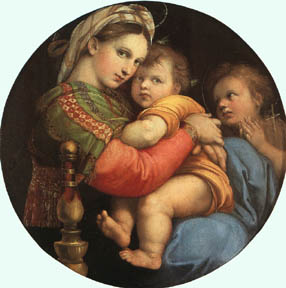Evolution in the History of Paintings of the Virgin
A consistent subject throughout the Renaissance was the depiction
of the Virgin Mary, depicted on her throne with the infant Jesus. By taking
a short survey, it is easy to follow advances in technical innovations as
well as design. Early representations of this subject tended toward a very
centralized location of the figure of Mary, surrounded by her attendant
angels. The gold background and "stacked" appearance of the angels
accentuates the flattened effect. An early Giotto Madonna adds a little
bit more 3-dimensionality and a more personalized (human) face, but the
angels continue to be a repetition of the same features, and the Christ
child appears formal and stiff. The gold background continues to serve as
an indication of her "holy residence", but it also serves to keep
the image locked in 2-dimensional space. With Masaccio, the Virgin finally
becomes flesh and blood, her figure defined as a sculptural model of form.
The throne becomes solid and 3-dimensional, and the angels begin to have
a sense of liveliness. Though the tradition of gold-gilding is still present,
it doesn't overwhelm the composition.
Fra Filippo Lippi (a friar who was rumored to give up his monastic life
for the love of his model) was one of the first artists to fully humanize
the image of the Virgin. With his paintings, there is no doubt that the
artist is looking at a flesh and blood woman as the inspiration for his
devotional image. The tender expression, studied anatomy, and clear sense
of light and shadow create a believable image of the Christ mother. Jesus
also appears to have the proportions of a real child, instead of that of
a tiny adult. The winged child holding him is the only supernatural element.
Leonardo's paintings of the Mary always feature her out-of-doors. The goddess
is removed from her throne to become more integrated with the natural world.
The composition becomes increasingly complex. Anne (Mary's mother) holds
the Virgin in her lap as Mary reaches for Jesus, who holds a young lamb
(an allusion to his role as the redeemer of man, "the sacrificial lamb").
.
Raphael is known as a master of Madonna painting, and probably painted
hundreds of different variations. "Madonna of the Chair" is
a lovely example. It's masterful design incorporates a series of rhythmic
curves which echo the circular frame. The chair post serves to stabilize
the composition.
|